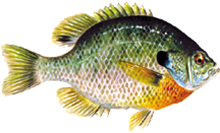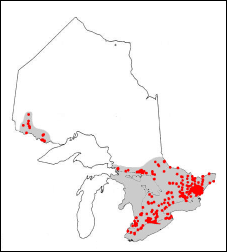Bluegill
Information about the Bluegill (Lepomus macrochirus), a warm-water fish native to Ontario.

Species image: Illustration Credit: Curtis Atwater
What it looks like
- small, very deep-bodied fish
- back and sides are green to brown with faint, dark bars
- belly is silver to yellow
- black ear flap with no pale edge
- black spot at rear end of dorsal fin
- unnotched dorsal fin with 10 to 11 spines
- 3 anal fin spines
- small mouth – ends before the middle of the eye
Size
- length: 15-22.5 centimetres (6-9 inches)
- weight: 200 grams (0.4 pounds)
- Ontario record: 800 grams (1.8 pounds)
Similar fish
- Rock Bass
- Pumpkinseed
- part of the sunfish family
Where it’s found

Species distribution map (modified from Mandrak and Crossman, 1992)
Range
- plentiful in many southern Ontario waters
- use Fish ON-Line, an interactive mapping tool, to find specific lakes and rivers
Habitat
Bluegill prefer:
- warmer lakes and ponds
- slow-moving, vegetated streams
- clear waters with some weed growth
Angling tips
- small fish form large, loose schools in shallow water near the shelter of weeds, docks, bridges or other cover
- bigger fish tend to stay by themselves, occasionally collecting in small groups
- feed all day
- easy to catch from shore and provide excellent action for children
- aggressive feeders, take bait readily and fight well on light tackle
- light line and small hooks work best
- try dangling live bait from a small bobber, fly-fishing, casting small lures, slow-trolling or drifting
Common baits
- small plugs, spinners or jigs
- live bait, like worms or insects
- add natural bait to an artificial lure to make it more appealing
Updated: January 04, 2023
Published: July 18, 2014